Why brokers should talk to clients about heat waves

Extreme heat is the main driver behind several climate-related perils now damaging Canadians’ properties, and things are shaping up to get worse by 2050-80, says a representative of Intact Centre.
“I’m going to spend a little bit of time talking about heat today, because heat is essentially the driver for all other weather-related catastrophes,” Caroline Metz, managing director of the Intact Centre on Climate Adaptation, told the Insurance Brokers Association of B.C. AGM and Leaders’ Conference in Vancouver.
“We have all these clients, and we have flooding, we have wildfire, hailstorms, windstorms — but the fundamental driver for this is heat, the fact that our planet and our atmosphere is warming.”
And while political efforts worldwide largely emphasize reducing carbon emissions to stabilize global temperatures, brokers are in a unique position to advise clients on specific things they can do to adapt to the changes, Metz says.
She was speaking about the effects of extreme heat during a panel discussion at the IBABC’s convention held in Vancouver on June 5-6.
Eleven days after the IBABC conference, at the time of writing, Toronto is under a heat warning with temperatures forecast to exceed 30 degrees Celsius throughout the week. Similarly, Montreal is under a heat warning, with the humidex expected to exceed 40 degrees Celsius.
Coming heat zones
In the future, three areas in Canada can expect to see increased heat over the next 25-65 years, Metz said.
“Across the country, there are really three pockets in Canada that have high heat exposure,” she said. “That’s going from the West Coast to the Rockies in B.C. Then we’ve got the Prairie communities in the centre. And then [in eastern Canada], you’ve got the area from Lake Erie, Lake Ontario, and up through the St. Lawrence River Valley.”
Since Metz was speaking in B.C., she spoke specifically about temperature changes in the province. However, she said brokers across Canada can get heat data for specific cities in their areas through climateatlas.ca. Brokers can use easily digestible information from this site to prepare clients for a discussion about climate change, she suggested.
Vancouver will see escalating temperatures as we near 2050-80, but Kelowna will be at the brunt of the projected heat spells in B.C., she projected.
“Kelowna ended up being [on] our top 10 list for various indicators,” said Metz. “We looked at three indicators — very hot days, warmest maximum temperatures, and length of heat waves….
“So, for Vancouver, what’s expected between now and the very recent past, from 1976 to 2005, and looking out to 2050 to 2080, we’re looking at going from one day 1718701807 to 16 days when we’re going to have temperatures above 30 degrees Celsius. And then for Kelowna, we’re going from 24 to 62 days. So you can imagine, two months of solid temperatures above 30 degrees Celsius. That’s pretty extreme.”
Brokers can help
And while politicians are sweating the big stuff, like how to get global temperatures to cool down, brokers and insurers have an important role to play in helping clients mitigate the damaging effects of extreme heat when they create conditions for catastrophes and secondary perils — such as floods and wildfires — resulting in property damage.
“Insurers and brokers can help play a role in having conversations [and] building protection against the physical impacts from climate change and extreme weather,” Metz said. “And then the importance of communicating on risks and coverages.”
Feature image courtesy of iStock.com/Xurzon







